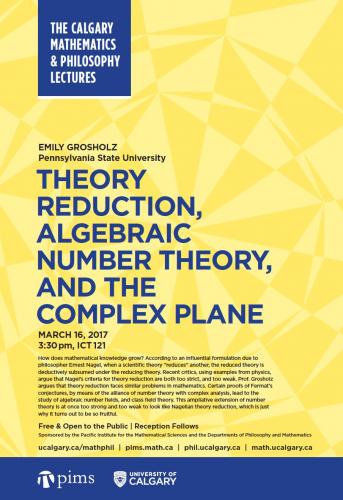The Calgary Mathematics & Philosophy Lectures: Emily Grosholz
Topic
Speakers
Details
How does mathematical knowledge grow? According to an influential formulation due to philosopher Ernest Nagel, when a scientific theory "reduces" another, the reduced theory is deductively subsumed under the reducing theory: thus for example chemistry is deduced from quantum mechanics, and molecular biology from chemistry. Recent critics, using examples from science, argue that Nagel's criteria for theory reduction are both too strict, and too weak. Prof. Grosholz reviews Nagel's model and its difficulties, and argues that theory reduction faces similar problems in mathematics. Certain proofs of Fermat's conjectures about whole number solutions of quadratic and cubic polynomials, by means of the alliance of number theory with complex analysis, lead not deductively but abductively (adding content) to the study of algebraic number fields, and class field theory. This extension of number theory is at once too strong and too weak to look like Nagelian theory reduction, which is precisely why it turns out to be so fruitful.
Biography:Emily Grosholz is Edwin Erle Sparks Professor of Philosophy at the Pennsylvania State University. She is the author of monographs on Descartes, Leibniz and the role of "productive ambiguity" in mathematics and the sciences. She edited a collection of essays on Leibniz, time and history, as a special issue of Studia Leibnitiana (44 / 1 2012), as well as collection of essays on modern cosmology and time as a special issue of Studies in the History and Philosophy of Modern Physics (52 / Part A 2015). Her new philosophy book Starry Reckoning: Reference and Analysis in Mathematics and Cosmology is just out from Springer in the SAPERE series edited by Lorenzo Magnani. Next year, Springer will publish her book on poetry and mathematics, Great Circles: The Transits of Mathematics and Poetry in a new series, Mathematics, Culture and the Arts, edited by Margerie Senechal, Jeremy Gray and Jed Buchwald.
A video of this is available on mathtube.org.

